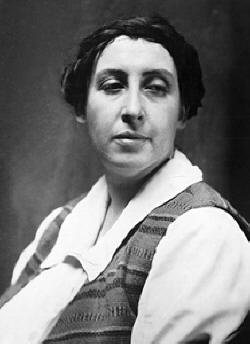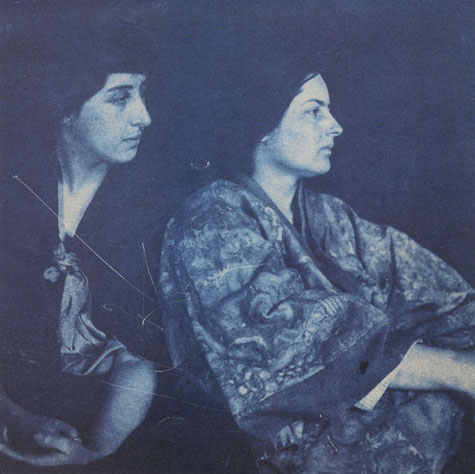Partner Florence Wyle
Queer Places:
Académie Colarossi, 10 Rue de la Grande Chaumière, 75006 Paris, France
School of the Art Institute of Chicago, 116 S Michigan Ave, Chicago, IL 60603
Tufts School of the Museum of Fine Arts, 230 Fenway, Boston, MA 02115
Art Students League of New York, 215 W 57th St, New York, NY 10019
6 MacDougal Alley, New York, NY 10011
110 Glenrose Ave, Toronto, ON M4T 1K8, Canada
Loring - Wyle Parkette, 1P4, 276 St Clair Ave E, Toronto, ON M4T 1P4, Canada
 Frances
Norma Loring, a Canadian sculptor, was born on October 14, 1887 in Wardner,
Idaho and died February 5, 1968 in Newmarket, ON. She helped organize
Emma Goldman’s drama lectures in Toronto; also helped
Goldman organize a campaign against corporal punishment in the Toronto
schools.
Frances
Norma Loring, a Canadian sculptor, was born on October 14, 1887 in Wardner,
Idaho and died February 5, 1968 in Newmarket, ON. She helped organize
Emma Goldman’s drama lectures in Toronto; also helped
Goldman organize a campaign against corporal punishment in the Toronto
schools.
In 1920 Lorning was a member
of both the Royal Canadian Academy and the Ontario Society of Artists, she was
a founding member (1928) and subsequently president (1940s) of the Sculptors'
Society of Canada. Later she was involved in the organization of the
Federation of Canadian Artists (1941) and the Canada Council (1950s). In 1960
she was the Canadian representative at the Venice Biennale. Loring was the
creator of two very famous sculptures in Canada, "The lion on the Queen
Elizabeth Way Monument" 1939, located now in Toronto and "The statue of Robert
Borden" 1957, located on Parliament Hill, Ottawa.[1][2]
Born in Wardner, Idaho on October 14, 1887 to mining engineer Frank Curtis
Loring (1859-1938)[2]
and Charlotte Moore,[3][4]
Frances Loring was a Canadian-based sculptor whose works can be found in many
galleries in Toronto, Ontario. Loring studied at multiple schools such as the
Ecole des Beaux-Arts in Switzerland, the Academie Colarossi in Paris, France,
the Chicago Art Institute, the School of the Museum of Fine Arts in Boston,
and at the Art Students League in New York City. Loring studied in Europe
before enrolling at the Art Institute of Chicago, where she studied with
Lorado Taft. At the Institute she met
Florence Wyle with
whom she was to have a lifelong partnership. In 1909 Frances moved to New York
City and was soon joined by Florence. The first of three studio homes they
would share over their lives was located on MacDougal Alley, a lively artist
colony in the heart Greenwich Village. Theirs was no. 6, a converted stable
with additional living space. Here they sculpted well-known portrait busts of
each another. The Loring-by-Wyle and Wyle-by-Lorning busts now the heartbeat
in the Loring-Wyle Parkette in Moore Park, Toronto, right beside where their
famous studio "The Church" was.[5]
In 1912 the two moved to Toronto and rented a studio-home, which was the whole
top-floor over a carpenters shop at the corner of Church and Lombard Street.
The building was called Hunters Inn. Eight years later, in 1920, Frances (age
33) and Florence (age 39) bought "The Church" at 110 Glenrose Avenue in the
Moore Park neighborhood.[6]
In addition to being their studio-home The Church was the official head office
for the Sculptors Society of Canada and the gathering place for Toronto's
artistic community. A. Y. Jackson called The Church "the most fascinating
gathering place in the country" and it has been described as the closest
Toronto came to having a Bohemian salon. Robertson Davies based characters on
them and The Church in The Cunning Man.[7]
In 1928 Loring and Wyle were founding members of the Sculptors' Society of
Canada with Alfred Laliberté, Elizabeth Wyn Wood, Wood's teacher and husband
Emanuel Hahn and Henri Hébert. She was made a member of the Royal Canadian
Academy of Arts[8]
Her work was often exhibited by the Women's Art Association of Canada.[9]
In 1960, works by Loring along with those of Edmund Alleyn, Graham Coughtry,
Jean Paul Lemieux and Albert Dumouchel represented Canada at the Venice
Biennale.[10]


MacDougal Alley
Frances Loring is famous for her unique sculptures,[11]
and produced and created hundreds of different pieces of art, including public
monument home-front sculptures during the First World War, war memorials after
the war,[7]
architectural sculptures, portraits, and garden sculptures. She was a member
and the founding of the Sculptors Society of Canada and the chief organizer of
the Federation of Canadian Artists and the Canada Council of the Arts. Loring
used to create her art based on what was happening around her in history and
she worked with a large variety of materials to make her sculptures. Loring
was known as well for her collaborations with Florence Wyle, including in
1928, at the University of Toronto they created a war memorial in Osgoode
Hall, the Library, and the Queen Elizabeth Way Monument (called by some the
"Loring Lion" due to Loring's contribution), located in Casimir Gzowski Park
since 1975. She also created a portrait of Prime Minister Robert Borden in
bronze and various war memorials in Cambridge, Ontario,
Loring is closely associated with fellow sculptor Florence Wyle, and they
were both known to become some of the first prominent Canadian sculptures.
Loring and Wyle are usually connected with each other because their
relationship, both personal and professional, lasted for over 60 years. Loring
and Wyle first met at the Art Institute of Chicago in 1905, which resulted in
a long friendship. Even though the two women were after the same commissions,
they often collaborated on multiple projects with each other. Before Loring or
Wyle's art promoted sculptures in Canada, there were very few sculptures due
to the lack of interested artists, shortage of foundries and the expensive
cost of materials were all factors of the lack of sculptors at that time, and
they often had to rely on commissions to gain money for needed material. After
Loring and Wyle's works have gained popularity, both artists contributed
significant influence on Canadian art by showing that the art of sculpting is
equally as important as any other art form. Loring and Wyle had moved into an
abandoned church in 1920, and it soon served as both their home and studio.
After their sculptures gained some popularity, the church became headquarters
for the Sculptor's Society of Canada, where Loring and Wyle both considered as
the founding members.
In 1913, Loring and Wyle moved in together in Toronto, and society started
referencing to them as "The Girls."[5]
Both of them were major forces in their careers and society at the time used
to require Loring and Wyle to make important sculptures during the World War
I, such as the monuments for the Queen and King in Toronto. After the War,
society started to have a movement for non-representational sculptures,
towards this path Loring's work started to lose the big popularity. However,
in a while later she got rediscovered by the academic's female artists. In
1968, Loring and Wyle passed away and they left all their money to support the
new generation of Canadians sculptors.
Rufus Wainwright (born
1973), Frances Norma Loring (1887-1968)
and Prescott Townsend
(1894-1973), all descend
from the same Pilgrims, Elizabeth Blossom and her husband Edward Fitzrandolph,
and John Tilley and his wife Joan Hurst (arrived with the Mayflower).

Tony
Scupham-Bilton - Mayflower 400 Queer Bloodlines
My published books:


BACK TO HOME PAGE

- https://en.wikipedia.org/wiki/Frances_Loring
 Frances
Norma Loring, a Canadian sculptor, was born on October 14, 1887 in Wardner,
Idaho and died February 5, 1968 in Newmarket, ON. She helped organize
Emma Goldman’s drama lectures in Toronto; also helped
Goldman organize a campaign against corporal punishment in the Toronto
schools.
Frances
Norma Loring, a Canadian sculptor, was born on October 14, 1887 in Wardner,
Idaho and died February 5, 1968 in Newmarket, ON. She helped organize
Emma Goldman’s drama lectures in Toronto; also helped
Goldman organize a campaign against corporal punishment in the Toronto
schools.



